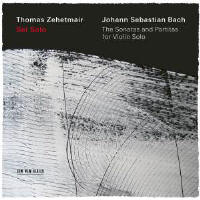Texte paru dans: / Appeared in: ECM 4818558 |
|
|
Outil de traduction (Très approximatif) |
|
|
Reviewer:
Rob
Cowan Fugues are imbued with an impressive sense of character while the gentle pulsing of the A minor Sonata’s Andante (with more decorated repeats) maintains its expressive intensity in spite of its relatively swift pace. Once into its stride the Chaconne (12'30") keeps up the pace: at 9'06" what normally arrives as hard-hitting rhythmic mobility is refashioned as totally free, unfettered I’d say, as is the passage that succeeds it, while the movement’s close defies tradition with unexpected quietness. The C major Sonata’s opening Adagio labours as if aching at the joints, though the ensuing fugue blossoms from an effective piano at the start. The Third Partita’s Preludio bounds in with great gusto, though here as elsewhere in the set you’re aware of a distant knocking sound, probably the force of the bow or of Zehetmair’s finger pads on the instrument’s fingerboard. Also, there’s the distant presence of what sounds like traffic outside the Church of St Gerold in Austria. One assumes that while the church’s generous acoustic suited Zehetmair’s musical needs to a T, close mics were necessary in order to offset the potentially blurring effect of excessive reverberation – and maybe block out some of the traffic too! But I hasten to add that the traffic element was more apparent through my Bose noise-cancelling headphones than through my Cambridge/Bowers & Wilkins room set-up. Zehetmair is among the most characterful of living violinists, a forceful personality whose ego is employed at the service of whatever music he happens to be playing. Everything he records is worth hearing and this new solo Bach set (his second of this repertoire, and quite different to his first), which is very well annotated, is no exception. Although very dynamic and expressively inflected it’s not music exactly a comfortable listen – Zehetmair has too much artistic integrity to compromise for the sake of mere comfort – but it’ll certainly make you think again about music that in any case defies an interpretative straitjacket. But the best there is? Not in my view. Among digital contenders, I incline more towards such equally stylish but less relentlessly assertive options as Isabelle Faust, Alina Ibragimova, Ning Feng and, for a period-instrument option, Giuliano Carmignola, who employs many of the stylistic devices that Zehetmair favours here. I’d say that, in the final analysis, his set is the best bet of all. |
|




